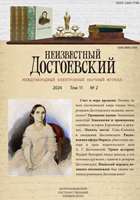Великое пятикнижие Достоевского: концепт, перевод, толкование
Dostoevsky’s Great Pentateuch: Concept, Translation, Interpretation
Author(s): Vladimir Nikolaevich ZakharovSubject(s): Russian Literature, Translation Studies, Theory of Literature, Sociology of Literature
Published by: Петрозаводский государственный университет
Keywords: Dostoevsky; novel; Pentateuch; translation; interpretation; concept; thesaurus; cultural code;
Summary/Abstract: Dostoevsky has been successfully translated into different languages. He remains himself even in unsuccessful translations. Every translation is an interpretation. Interpretations include not only critical publications, but also theatrical productions and screen adaptations. Translations and interpretations expand the corpus of Dostoevsky’s texts. Translation is universal. Dostoevsky is in demand for translations not only into foreign languages, but also from Russian into Russian: manuscript to printed text, printed text to multimedia format. Over the last hundred years, the graphics, orthography and punctuation of the Russian language have changed. Changes in the language distort the meaning of Dostoevsky’s works. Both the shortcomings and the achievements of Soviet and post-Soviet textology are most fully presented in the Complete Works of Dostoevsky. They resulted in the amended texts of the writer, which, in turn, required new translations into foreign languages. The concept of “Dostoevsky’s Pentateuch” is tentative. Had Dostoevsky lived longer, he may have written more great novels: not five, but six or more. And now “Poor People,” “Notes from the Dead House,” “Notes from Underground,” “Diary of a Writer” are added to Dostoevsky’s five great novels . Of the different Pentateuchs, there are two personal ones: one by Moses, the other by Dostoevsky, which was immediately labeled “great.” The concept of the “great Pentateuch” has many authors. It became common place in conference debates as early as the 1970s. At first, it was a rhetorical figure that stated the number of Dostoevsky’s famous novels. At present it is a concept that expresses the ideological content, genre and poetics of the writer’s late novels.
Journal: Неизвестный Достоевский
- Issue Year: 11/2024
- Issue No: 2
- Page Range: 5-15
- Page Count: 11
- Language: Russian

